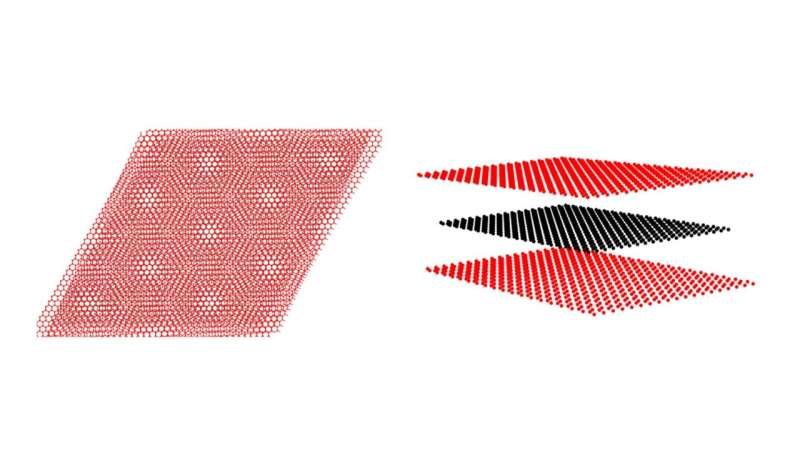April 4, 2024 feature
This article has been reviewed according to Science X's editorial process and policies. Editors have highlighted the following attributes while ensuring the content's credibility:
fact-checked
peer-reviewed publication
trusted source
proofread
Unlocking exotic physics: Exploring graphene's topological bands in super-moiré structures

In a new study, scientists from Singapore and Spain have presented a new avenue for exploring exotic physics in graphene. They focus on electronic interactions in graphene when it is sandwiched in a three-layer structure which provides a platform to exploit unique electronic band configurations.
Graphene is a 2D sheet of carbon atoms arranged in a hexagonal lattice (arrangement) which demonstrates properties like high electrical conductivity, mechanical strength, and flexibility. This has grabbed the interest of scientists as a promising candidate for electronic applications.
However, very little has been studied about the electronic properties of monolayer graphene.
In this new Physical Review Letters study, the researchers focused on studying these properties by sandwiching graphene between two bulk boron nitride layers.
The work was part of the first author, Mohammed M. Al Ezzi's Ph.D. at the National University of Singapore (NUS), who is now working as a post-doc under Prof. Shaffique Adam at NUS.
Moiré potentials, patterns, and lattices
In material science, different layers of materials are stacked on top of one another to create a new structure known as a moiré structure. These layers are misaligned leading to the formation of a moiré pattern.
These layers interact with each other through various forces, in this case, through van der Waal forces. This leads to variations in the potential energy experienced by the electron within the material (graphene or boron nitride), known as the moiré potential.
So, the moiré potential arises from the interference between the atomic arrangements of the two materials, resulting in a periodic modulation of the potential energy within the graphene layer.
This moiré potential plays a crucial role in influencing the electronic properties of the material and can lead to the emergence of unique phenomena such as flat bands and topological states.
Three layers and topological bands
The researchers propose a three-layer structure, with the graphene layer in the middle to induce topological bands. The resulting structure is known as a super-moiré structure.
It is called a super-moiré structure because there are two distinct moiré structures, from the top and bottom boron nitride substrates. This gives rise to some exotic physics, which is to say unconventional physics.
Prof. Adam explained, "By situating graphene between the boron nitride substrates and adjusting the alignment to specific twist angles, we can induce topological flat bands in graphene's energy spectrum. These flat bands, in turn, likely host robust strongly correlated electron states."
Topological bands are a unique electronic state in a material that has special properties due to its unusual structure. They represent a departure from conventional electronic states like conductors or insulators.
For their work, the researchers specified twist angles of 0 degrees for the bottom boron nitride layer and around 0.6 degrees for the top boron nitride layer. These angles represent the amount of rotation applied to the layers relative to their original orientations.
The researchers' model for the three-layer structure showed the existence of a topological flat band as a result of the moiré potential.
These flat bands represent flat energy levels, meaning that the energy of the electrons within these bands does not change much as their momentum varies (think of it as walking across a plateau).
Correlated physics and generalization
The question that arises now is: What is the significance of these topological flat bands?
The existence of these flat bands is a unique property and can be used to harness different electronic properties and therefore, unique electronic applications.
For example, topological insulators behave as insulators in their bulk but conduct electricity along their surface or edges.
The researchers think these topological flat bands for monolayer graphene could give rise to correlated physics, in which the electrons behave as a collective unit (via Coulombic interactions), giving rise to novel electronic states, such as superconductivity, magnetism, and insulating phases.
Prof. Adam explained, "Various moiré systems made of multiple monolayer graphene sheets have shown the emergence of correlated physics and flat bands. However, there is currently no unified understanding of the emergence of flat bands and correlated physics in these different moiré systems."
"One way to have a unified understanding of the emergence of flat bands and correlated physics in all the different graphene-based moiré systems is to study flat bands in a single monolayer sheet. Studying a single monolayer graphene can tell us the minimum ingredients to show flat bands and correlated phases."
The researchers also demonstrated generalization by extending their findings to graphene bilayer and trilayer configuration, showing potential for superconductivity.
They further showed that these topological flat bands were extremely stable, indicating their robustness and reliability for supporting correlated physics.
Preserving quality and topological transistors
There are several other methods to induce these strong electronic interactions that give rise to correlated physics. But, some of them can affect the graphene quality itself.
"One common method to induce strong electron interactions in graphene involves mechanical deformation. However, this approach often compromises the quality of graphene and poses challenges in control."
"Our method promotes stronger electronic interactions by inducing flat bands while preserving graphene's intrinsic high-quality properties," said Prof. Adam.
The researchers are already involved with a company called FLEET who are developing topological transistors and hope that their work with topological flat bands can help realize new devices.
The findings are exciting for the development of novel graphene-based electronics and also further the understanding of condensed matter physics and exotic physics.
More information: Mohammed M. Al Ezzi et al, Topological Flat Bands in Graphene Super-Moiré Lattices, Physical Review Letters (2024). DOI: 10.1103/PhysRevLett.132.126401. On arXiv: DOI: 10.48550/arxiv.2306.10116
Journal information: Physical Review Letters , arXiv
© 2024 Science X Network




















